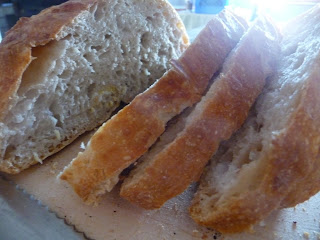 I saw Aida make this dish on FoodNetwork over winter break. The fact that I remember this is all too impressive--I had my wisdom teeth removed and remember very little from those few pudding-filled days of my life. It reappeared on SmittenKitchen when I returned to school, and I couldn't help but whip up a batch.
I saw Aida make this dish on FoodNetwork over winter break. The fact that I remember this is all too impressive--I had my wisdom teeth removed and remember very little from those few pudding-filled days of my life. It reappeared on SmittenKitchen when I returned to school, and I couldn't help but whip up a batch.This recipe would have served a lot of people. I'm fairly certain just Matt and I ate it that night, and then I had leftovers for the rest of the week. Every morning I'd make some Minute-Rice to pack along with some of this stew.
And what a stew it was! I loved the combination of chickpeas and butternut squash, and the heartiness of the potatoes. If I would have added the olives, I'm sure I would have loved it even more. If you've never tried cinnamon in savory food, this is a good first step. This stew isn't hot like you'd expect either, but extremely fragrant from the cinnamon and a little spicy from the cumin.
I omitted some ingredients and changed the recipe to be a more "on the fly" (read: realistic) version, so I can't speak to its authenticity (see Smitten Kitchen's version here, which includes saffron, preserved lemon, cilantro and almonds). It is, however, delicious.
With this recipe, I found it very wise to chop everything ahead of time, as if you were doing a demo on television.
Moroccan Stew
Serves 6-8
1 tablespoon unsalted butter
1 tablespoon olive oil
1 medium yellow onion, small dice
4 medium cloves garlic, diced
2 teaspoons ground cumin
1/4 teaspoon cinnamon or 1 (3-inch) cinnamon stick (if you've got that on hand)
Salt and freshly ground black pepper
1 pound butternut squash, large dice
3/4 pound potatoes, large dice (the recipe suggests red, I used Idaho because they were on sale)
2 cups low-sodium chicken or vegetable broth (I used Rapunzel Vegan Herb Bullion cubes)
1 (14-ounce) can chickpeas, drained (roughly two cups)
1 (14-ounce) can diced tomatoes, with juices
1 cup brined green olives (optional)
1. Heat butter and olive oil in a good, solid soup pot or dutch oven (with a lid) over medium heat. Add onion, garlic, cumin, and cinnamon, and season with salt and freshly ground black pepper. Cook, stirring occasionally, until spices are aromatic and onions are soft and translucent, about 5 minutes.
2. Add squash and potatoes, season with salt and freshly ground black pepper, stir to coat, and cook until just tender, about 3 minutes (Idaho potatoes will take longer).
3. Add broth (I used Rapunzel Vegan Herb Bullion cubes), chickpeas, tomatoes and their juices, and saffron, if using. Bring mixture to a boil then reduce heat to low. Cover and simmer until squash is fork tender, about 10 minutes.
4. Serve with rice or couscous.




 I have a petty complaint to share. Pastors and future pastors take note.
I have a petty complaint to share. Pastors and future pastors take note.




